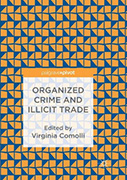Organized Crime And Illicit Trade: How To Respond To This Strategic Challence In Old And New Domains

Editor: Virgina Comolli
Publisher: Cham, SWIT: Palgrave Macmillan, 2018. 143p.
Reviewer: Stefano Caneppele | July 2019
Virginia Comolli’s book collects a series of contributions written on the issues of criminal organizations and their role in illicit trade. The book tackles the subject from different corners. Vanda Felbab-Brown’s contributions discusses how illicit economies can undermine rule of law (Chapter 1) and on the necessity of a holistic approach to restore the rule of law, which brings to a reconsideration of external (US and EU) assistance (Chapter 6). Tuesday Reitano’s chapters discuss the evidence on the detrimental contribution of organized crime to sustainable development (Chapter 2) and the issues of the measurement of OC activities together with the need to refocus security policies on communities (Chapter 5). From another perspective, Camino Kavanagh (Chapter 3) describes the multiplier effect of cyberspace for transnational crime while Karl Lallerstedt (Chapter 4) describes the efforts that have been made at international level to develop a methodology which measures illicit trades and its wider impact. The book is a spin-off of a project run jointly by the Security and Development Programme and the Geo-economics and Strategy Programme at The International Institute for Strategic Studies with the support of HSBC and British American Tobacco.
The book discusses the implications of the organized crime and illicit trades for communities (mainly based in third and fourth world countries) and the responses that could be put in place. Contributors present real examples on the externalities of organized crime and they are able to show how – in some regions – legality and illegality are intertwined in a complex relationship which requires a deep understanding of the context and ad hoc strategies. Indeed, in failed and/or highly corrupted states, illicit economies (IEs) provide a minimal income to survive to large groups of people. IEs can be therefore used not only to make profit but also as source of consensus and control by terrorist and criminal groups and, sometimes, even by corrupted government officials. Therefore, a dismantling strategy could be ineffective if not followed by plans to provide support and economic development in the region. Interestingly, one chapter describes the multiplier effect that IT has played on transnational crimes, providing an historical overview of the evolution across the past years.
In general, the evidence provided in the book is still anecdotical: the mention to the involvement of terrorist groups in tobacco smuggling – probably because BAT is one of the sponsors – is recurrent but not based on systematic evidence. Even the so-called organized crime–terrorism nexus lacks of general consensus in academia. Despite these criticisms, it is worthwhile to remark that the book stresses the importance of more reliable data to study the phenomenon, and to assess what works in security policies. One attempt has been made on measuring the impact of illicit trades and, even considering all possible methodological flaws, this is a welcomed direction toward an empirical knowledge-based approach. Indeed, you should not be surprised to read in the conclusion that integrated approaches, holistic strategies and tailored solutions are preferable to indiscriminate law enforcement.
Finally, the book provides an overview of the challenges that local and international organizations have to face when dealing with tackling illicit trades. Generally, readers with security and political science background may find interesting the entire book, while an audience of criminologists may find useful Chapter 1 (threat of illicit economies), Chapter 3 (organized crime and IT) and Chapter 4 (measuring illicit trade) but less useful the other chapters because too general with regard to the threats posed by criminal organizations, their evidence, their role in different illicit trades and to what it is effective or not in tackling the problem.
Stefano Caneppele (Phd), Associate Professor in Criminology, School of Criminal Justice, University of Lausanne, Switzerland


